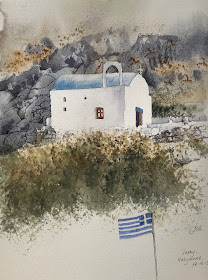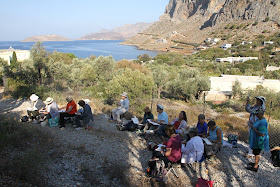Note - I try to regularly update posts with additional information but they don't normally repost. I wrote this post in 2013 and, for some reason, this re-posted in 2019 when I updated it. So I've updated it again to make it completely current!
I am often asked what other colours I use or like, and why. There are rather a lot. I have posted a paint-out of my main studio palette before, which I have recently updated. This would have some of my top 20 pigments, and allows me to paint almost anything I choose as it has a good range of yellows, reds, blues, greens and neutrals. These are all Daniel Smith watercolours as follows:
- Yellows -
- Hansa Yellow Medium as my mid or primary yellow
- Quinacridone Gold as my warm yellow
- Goethite DS as my earth yellow
- Raw Umber as my dark cool brown
- Reds/Oranges -
- Quinacridone Rose as my cool and purple-mixing red
- Transparent Pyrrol Orange as my warm red (note 2019 - this colour seems to have changed to a mid orange rather than a red-orange so pyrrol scarlet is probably more useful here),
- Indian Red as my earth red
- Pyrrol Crimson as my deep crimson. (In my smallest travel palette I sometimes use Carmine in place of the crimson and rose pigments)
- Blues -
- Phthalo Blue Red Shade as my cool blue.
- Ultramarine DS or DV, as my warm blue
- Cerulean Chromium as my liftable granulating cool blue
- Indanthrone Blue just because I love it - a deep warm blue.
- Greens -
- Phthalo Green Blue Shade as a mixing green
- Undersea Green mix DS (PB29+PO49) for foliage and leaves
- Sap Green (PO49 + PG7) for foliage, botanicals
- Perylene Green that is so useful for foliage in shadow.
- Neutrals -
- Buff titanium which is so useful for urban and beach subjects
- Burnt Sienna PBr7 is my preferred pigment for Burnt Sienna
- Burnt Umber as my warm deep brown
- Jane's Grey mixture of Burnt Sienna and Ultramarine. This is the one I refill the most.
Here is the palette - In the first photo from 2013 I arranged the colours with all the yellows together in the first column, then all the reds, then the blues, then greens, then earths. There is more on this arrangement here.
 |
| My 20 colour brass studio palette from littlebrassbox - photo from 2013. |
I now have them in a more 'rainbow' order with light buff titanium, then yellows running down the first column, into reds, blues, greens and then the earths. This is how I tend to arrange all my palettes.
 |
| My 20 colour brass studio palette from littlebrassbox in 2019 - same colours but in a different order. |
 |
| My studio palette colours. |
So then what to do with the colours I want to use on occasions but not all the time?
One option was to use a bigger palette. I had a wonderful large palette that worked very well in many ways. It held 34 colours and had good mixing areas but it took up a lot of space on my work desk and was not easily portable if wet so it was really only good in my studio. (Called the Bullet Proof Palette, by the way, though it is not actually made of glass but strong plastic.) It also had a number of colours that were more for special use than for all the time. My brass one is very compact when not in use, with great mixing space during use. What I wanted was a separate 'extras' set that I could keep in the drawer when not in use but pull out easily when painting in my studio. I've ended up using a set of 18 half pans in a custom made brass box. It works fine :-)
So what are these special extras?
 |
| My studio 'extras' palette. |
Some are opaque versions of colours I have, some are more granulation, some are cool yellows for florals. They are colours that have their uses in particular paintings. I try to limit the number of pigments I use in any one painting but I like to have a good range to choose from.
Included in this little extras set might be -
Cadmium Yellow Light - an opaque yellow for when more coverage is required or Hansa Yellow Light Daniel Smith PY3 which is a lovely transparent cool yellow.
New Gamboge - the original PY153 version from Daniel Smith. It is the most lovely transparent warm yellow I have tried. Mixable, but at times it's good to start with a single pigment colour. Hansa Yellow Deep is another excellent option.
Benzimida Orange Deep DaVinci - this is a gorgeous orange with a lovely and unusual orange undertone. Once again it is mixable, but just lovely. Or Transparent Orange Schmincke, which is more transparent and has a more yellow undertone. 2019 update - The DS Transparent Pyrrol Orange that I use in my main palette as a warm red seems to have changed to more of a true mid orange - rather like the Benzimida Orange Deep, Winsor & Newton Transparent Orange and almost the Schmincke Transparent Orange. It would now sit in with my extras and I'd change the main palette to Pyrrol Scarlet for the warm red.
Pyrrol Scarlet DS - a very lightfast warm red. I like the pyrrols and they intermix very well. A bright red can be perfect for certain flower studies. This is the red I recommend in all my teaching, rather than the Transparent Pyrrol Orange that I have in my main palette.
Quinacridone Lilac DS - this is the lovely PR122 magenta that makes the most gorgeous purples, and is prefect for painting bougainvillea. It's great if I want to work in a limited CYM palette too! Not currently in my extras palette as I use Quinacridone Rose to make most purples.
Imperial Purple DS - purely convenience if painting purple flowers. Some might prefer a PV23 Dioxazine violet.
Moonglow DS - this mix of Ultramarine, Anthraquinoid Red and Viridian is just lovely for many floral shaded areas.
Cobalt Blue - this lovely mid or primary blue doesn't get a lot of use, though it's wonderful in the Greek Islands and for skies.
Phthalo Blue GS DS - this is the colour I recommend in all my teaching, rather than the Red Shade that is in my main palette. I have it for demonstration purposes for my on-line tutoring since it is a traditional choice for most people. The Red Shade can be adjusted to look like the Green Shade with the addition of a little Phthalo Green.
Cobalt Turquoise DS - this is an easy enough colour to make but the granulation is something special.
Jadeite Genuine DS - this granulating pine-like green is a beautiful pigment. It mixes a bit like Phthalo green but is much deeper in mass-tone, more like Perylene Green, and more liftable thatn phthalo green. Wonderful in foliage. Still in my little travel palette.
Green Apatite Genuine - I love this colour and use it often. Goes from a light green gold through a sap green to a deep undersea green all in one - still in my little travel palette.
Serpentine Genuine DS - wonderful fro grassy meadows, with lovely flecks of brown in the green wash.
Green Gold - PY129 DS - this is another useful convenience colour for botanicals and foliage.
Yellow Ochre PY43 DS - an earth yellow that is a little opaque. Makes great olive greens, when I don't want the granulation of Goethite.
Raw Sienna PBr7 DS - for skin tones or if I want a warm glow in the sky without it turning green mixed with a blue - one of the characteristics of this pigment.
Transparent Red Oxide DS- this is an option for a burnt sienna but is wilder so I keep it for special purposes, especially rust. Fabulous granulation!
Piemontite Genuine DS - a granulating Primatek colour that has an amazing tonal and colour range. It washes down to a dusty pink. A very interesting alternative to Indian Red, but I like to use both.
Grey Titanium DS - introduced in 2019, along with Jane's Grey, this is an interesting colour that can be just perfect for concrete, neutral passages in a wash and some stone effects. I tend to use this in my plein air extras palette too.
Lunar Black DS - I don't generally use a black pigment but I love this one due to its extraordinary granulation.
Grey Titanium DS - introduced in 2019, along with Jane's Grey, this is an interesting colour that can be just perfect for concrete, neutral passages in a wash and some stone effects. I tend to use this in my plein air extras palette too.
Lunar Black DS - I don't generally use a black pigment but I love this one due to its extraordinary granulation.
 |
| My 'extras' palette colours |
I have many other watercolours that I don't use so often so my other problem was how to store and potentially carry these extra pigments when teaching colour workshops. I found the answer that solved all the rattling pans and wrote about Malcolm Carver's flower palettes, and my 'special use' pigments in another post - here. I have also written about 48 'special pigments' that I put into a MAC travel case here, with more detail in the following post here.








